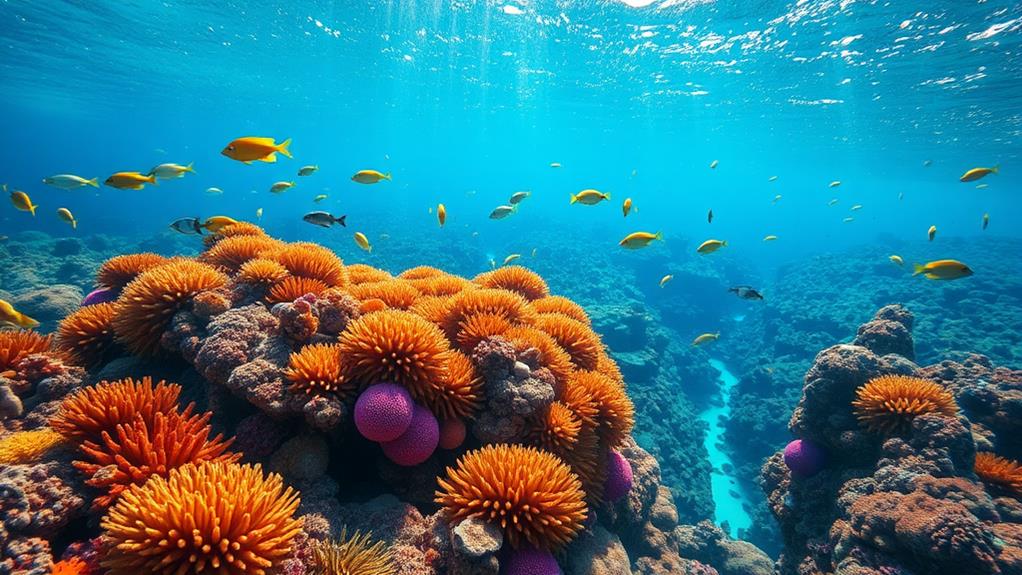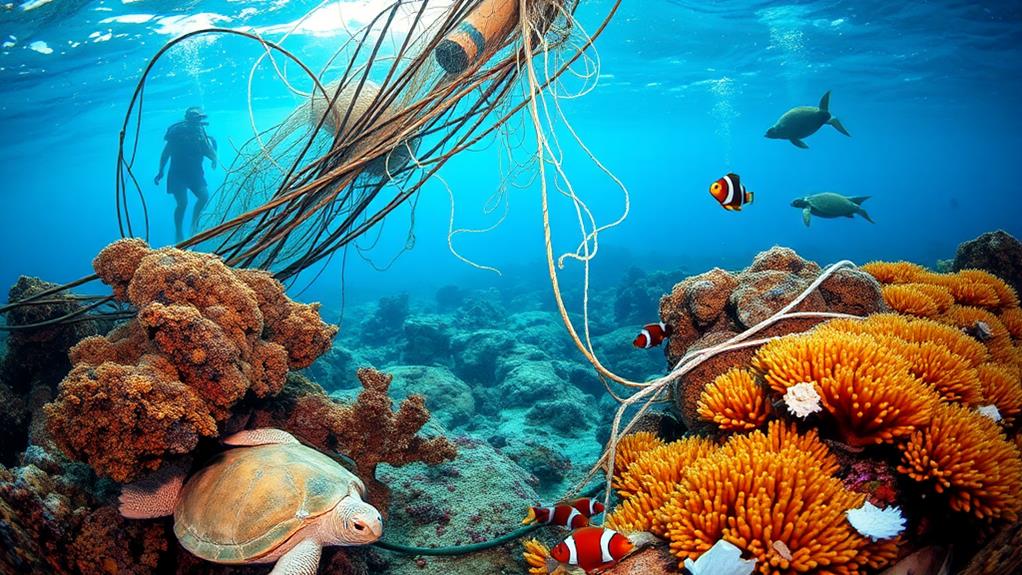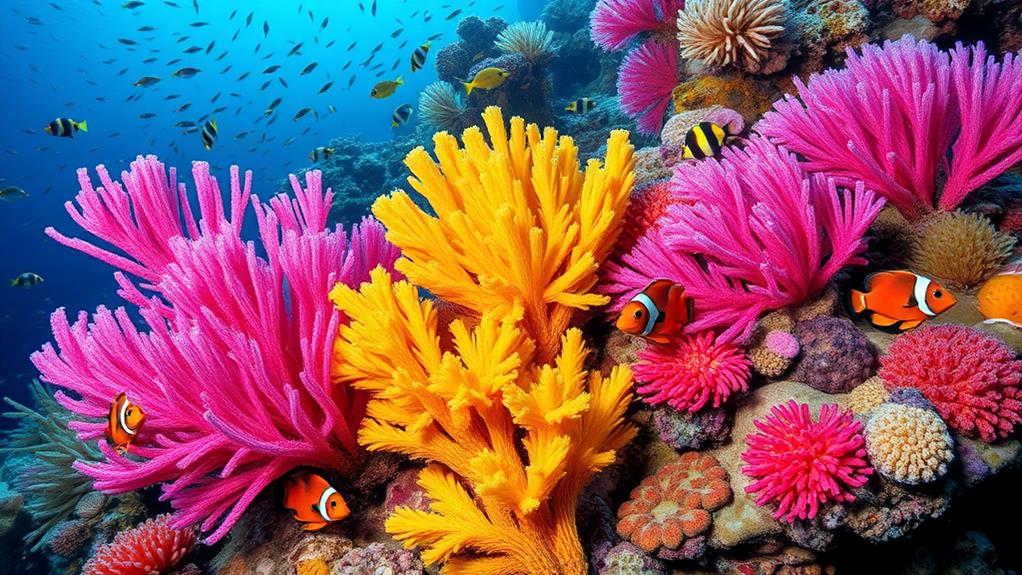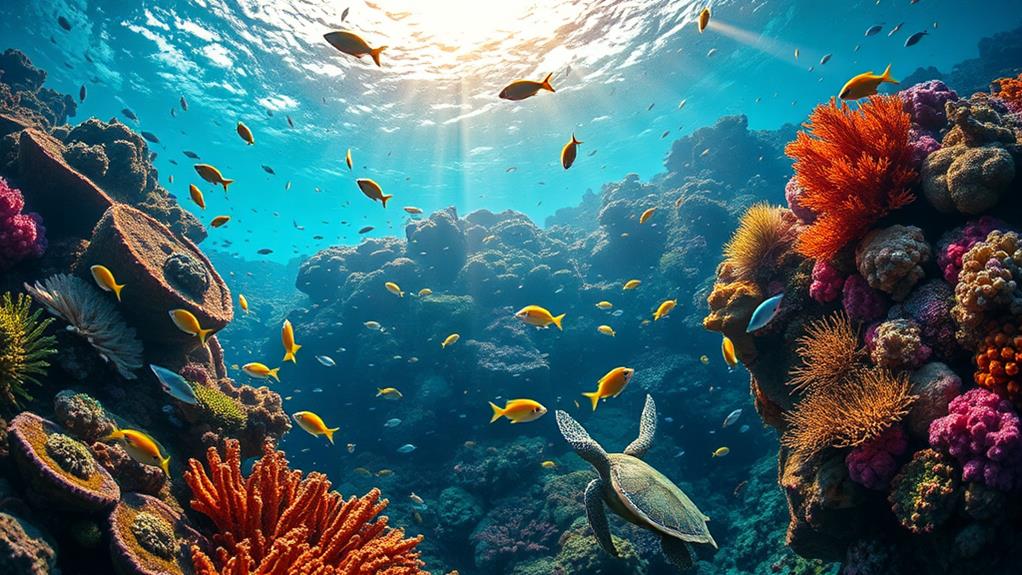The Philippines is home to a vast array of coral reefs, covering over 22,000 square kilometers.
These reefs support an incredible 500 coral species and approximately 1,800 species of reef fish. This dynamic ecosystem provides critical breeding grounds for marine organisms and supports immense biodiversity, earning it the nickname "Amazon of the Seas."
One of the most significant threats to these reefs is climate change. Destructive fishing practices also jeopardize their vitality.
Unfortunately, only 3% of these reefs are currently protected, highlighting the urgent need for conservation efforts.
Overview of Coral Reefs

Coral Reefs: A Vital Part of Marine Ecosystems
The Philippines is home to one of the most impressive displays of marine biodiversity, with coral reefs spanning over 22,000 square kilometers. These reefs are part of the globally recognized Coral Triangle, known for its rich biodiversity.
Coral Species and Colors
The reefs are home to over 500 coral species, including stunning branching and boulder varieties that display a dazzling array of colors – pink, purple, blue, and green.
Habitats for Marine Life
These reefs serve as vital habitats for approximately 1,800 species of reef fish, alongside iconic creatures like sea turtles and whale sharks. The diverse underwater landscapes contribute to the ecological balance, earning them the nickname "Amazon of the Seas."
Conservation Efforts Needed
Despite their ecological significance, only 3% of the Philippines' coral reefs are currently protected.
This alarming statistic highlights the urgent need for conservation efforts to ensure the survival of these vital ecosystems.
Without intervention, the rich biodiversity that defines the coral reefs may face irreversible decline, affecting marine life and the communities that depend on these ecosystems for sustenance.
Marine Biodiversity in the Philippines
The Philippines, situated within the Coral Triangle, is renowned for its exceptional marine biodiversity, comprising over 500 species of coral, which is approximately three-quarters of the world's known coral species. This remarkable concentration of coral species creates a sanctuary for marine life, with coral reefs spanning an area equivalent to Ireland and supporting around 1,800 species of reef fish, as well as sea turtles and whale sharks.
Ecosystem Richness: The coral reefs serve as a foundation for complex ecosystems, sustaining a vast array of marine species. For instance, coral reefs provide food, shelter, and breeding grounds for numerous species, including fish, crustaceans, and mollusks.
Marine Protected Areas: The Verde Island Passage is a prime example of the significance of marine protected areas, which are crucial for conserving vulnerable species against threats such as overfishing and pollution. These protected areas ensure the long-term survival of species that inhabit the coral reefs.
Environmental Threats: Approximately 40% of the coral reefs in the Philippines face significant risks from climate change and other environmental stressors, necessitating immediate conservation efforts.
Rising sea temperatures and ocean acidification pose significant threats to the survival of coral reefs, highlighting the need for urgent action to protect this delicate ecosystem.
Top Diving Locations

The Philippines boasts some of the world's most spectacular diving locations, attracting divers from around the globe due to its rich marine ecosystems and stunning underwater landscapes.
Tubbataha Reefs Natural Park, a UNESCO World Heritage site, showcases over 600 fish species. Accessible via liveaboard from March to early June, it offers unrivaled encounters with vibrant marine life amidst breathtaking coral formations.
El Nido features accessible reefs, perfect for beginner divers and underwater photographers alike. The area's crystal-clear waters are home to diverse marine species thriving in harmony.
Coron offers adventure-seekers World War II wreck dives, complemented by lush coral gardens at Siete Pecados Marine Park.
Apo Reef, the second-largest contiguous coral reef system globally, presents a unique diving experience with its diverse habitats and rich tapestry of marine biodiversity. This makes it a prime spot for both novice and experienced divers.
Each of these locations showcases the Philippines' unparalleled underwater beauty and vibrant marine ecosystems.
Conservation Challenges
Coral reefs in the Philippines face significant conservation challenges that threaten their health and sustainability. These challenges arise from a combination of human activity and environmental factors.
Human Activities Harm Coral Reefs
Destructive fishing practices, such as blast fishing and cyanide use, devastate marine life and significantly degrade coral ecosystems. These practices destroy the reef structure itself, causing both immediate and long-lasting damage.
Climate Change Affects Coral Reefs
Climate change poses a significant threat to coral reefs. By 2050, over 90% of Coral Triangle reefs could be affected by ocean warming and acidification. These changes disrupt the delicate balance of marine life, causing widespread bleaching events.
Inadequate Protection of Coral Reefs
Only 3% of the Philippines' coral reefs are currently protected, which is far below the recommended 20-30% necessary for effective conservation. This lack of protection exacerbates the effects of pollution and extreme weather events, further threatening critical habitats.
Addressing these conservation challenges is essential to preserve the vibrant marine life that thrives in the Philippines' coral reefs.
Environmental Threats

Coral reefs in the Philippines are under threat from multiple environmental factors.
Climate change poses a significant risk, with over 90% of the Coral Triangle reefs projected to be severely impacted by warming and acidification by 2050. This will lead to mass coral bleaching, endangering coral species and disrupting the delicate balance of marine ecosystems.
Destructive fishing practices are another major threat. Blast fishing and cyanide use not only deplete fish populations but also inflict substantial damage on coral ecosystems, diminishing marine biodiversity.
For example, blast fishing destroys coral formations, while cyanide use kills coral and other marine life.
Pollution from land-based sources is a grave threat. Agricultural runoff and plastic waste deteriorate reef habitats, making corals more susceptible to disease and reducing their resilience.
For instance, fertilizer runoff promotes algae growth, which outcompetes corals for space and resources.
The COVID-19 pandemic has worsened the situation. Economic pressures on local communities have led to an increase in illegal fishing practices, threatening the integrity of coral reef ecosystems and compounding existing vulnerabilities.
Without immediate and effective intervention, these threats could lead to irreversible damage to the rich marine life that relies on healthy coral reefs.
Photography of Coral Reefs
Coral Reef Photography: A Vital Tool for Raising Awareness
Photography plays a crucial role in highlighting the importance of coral reefs by capturing their mesmerizing beauty. Underwater photography techniques, such as image duplication and reversal, create stunning kaleidoscopic designs that emphasize the vibrant colors and intricate patterns of coral reefs.
Effective Techniques for Capturing Coral Reefs
To effectively capture the essence of coral reefs, consider the following techniques:
1. Utilize Flashes: Flashes enhance colors that might otherwise appear monochromatic, resulting in a more vivid representation of the ecosystem. This is particularly important when capturing images in deep water, where natural light is limited.
2. Innovative Editing: Post-processing techniques can highlight the unique textures and formations of coral species, emphasizing their ecological significance. For example, adjusting the contrast and saturation of an image can draw attention to the intricate details of coral structures.
3. Focus on Diversity: Coral reefs are home to a vast array of species, with over 500 species of coral and nearly 1,800 species of reef fish in the Philippines alone.
Aim to capture the rich tapestry of life present in these underwater landscapes by including a variety of species in your images.
Unique Coral Species

The Philippines is home to over 500 distinct coral species, representing approximately three-quarters of all known coral species globally. This impressive diversity is showcased through various coral formations, including branching corals, boulder corals, and plate corals, which display vivid colors like pink, purple, blue, and green.
These unique coral structures provide essential habitats for around 1,800 species of reef fish, such as clownfish and butterflyfish. The intricate relationships between coral and marine life highlight their ecological significance. For example, coral reefs serve as breeding and feeding grounds for various marine species, supporting the complex web of life within these rich underwater habitats.
Healthy coral reefs are critical for the overall health of marine ecosystems. They provide vital services, including breeding and feeding grounds for marine species, as well as supporting the complex web of life within these rich underwater habitats.
The vibrant coral species in the Philippines are essential not just for their beauty but for their role in maintaining the health of marine ecosystems.
Diving Experiences and Tours
Discover the Philippines' Unparalleled Diving Experiences
The Philippines is renowned for its vibrant underwater landscapes, boasting a rich biodiversity supported by its unique coral species.
The Coral Triangle is home to some of the world's most stunning marine environments, featuring destinations like Tubbataha Reefs Natural Park and Apo Reef, which showcase over 500 coral species and 2,000 fish species.
Exceptional Diving Experiences:
Tubbataha Reefs Natural Park, a UNESCO World Heritage Site, is famous for its pristine reefs and incredible biodiversity, offering divers a chance to see large pelagic species.
Coron and El Nido are perfect for island hopping tours, featuring crystal-clear waters and vibrant marine life, ideal for both snorkeling and diving.
Siete Pecados Marine Park is known for its diverse coral gardens and wreck diving opportunities, accommodating both beginners and seasoned divers.
Responsible Diving Practices:
Local tour operators provide efficient last-minute bookings and emphasize responsible diving practices.
With the right scuba gear and guidance, you'll create unforgettable memories while exploring the Philippines' breathtaking underwater realms.
Supporting Coral Conservation

Coral reefs in the Philippines are vital to marine biodiversity and local economies, covering over 22,000 square kilometers. However, only 3% of these reefs are currently protected, highlighting the urgent need for expanded Marine Protected Areas (MPAs).
To effectively support coral conservation, a target of 20-30% protection is essential.
Community engagement is critical to coral conservation, as it empowers local populations to participate in conservation practices. This approach enhances fish biomass and improves local fisheries, fostering stewardship and ensuring that the benefits of healthy reefs are shared among those who depend on them.
For example, community-led conservation efforts in the Philippines' Verde Island Passage have led to a significant increase in fish populations and improved livelihoods for local fishermen.
Sustainable tourism initiatives provide alternative livelihoods for coastal communities, reducing reliance on destructive fishing practices and promoting both economic resilience and coral reef conservation.
By supporting eco-friendly tourism, local communities can benefit from the preservation of their coral reefs, while also protecting their environment.
Immediate action is necessary to protect coral reefs from climate change, which threatens over 90% of Coral Triangle reefs by 2050.
Supporting MPAs and engaging communities through sustainable tourism is crucial to preserving these vibrant ecosystems for future generations.
Questions and Answers
What Is the Condition of the Coral Reefs in the Philippines?
The condition of coral reefs in the Philippines is alarming. Rising ocean temperatures due to climate change are causing increased coral bleaching, which threatens the rich biodiversity of these ecosystems.
Only 3% of coral reefs in the Philippines are protected, making marine conservation efforts crucial to preserve these vital ecosystems.
Effective ecosystem restoration is necessary to combat illegal fishing practices and habitat loss that further exacerbate the decline of coral reefs.
Immediate action is necessary to prevent the continued decline of coral reefs, which would have devastating consequences for both marine life and local communities.
What Is the Most Colorful Reef in the World?
The most colorful reef in the world is home to a diverse array of vibrant species. These species showcase dazzling hues and intricate patterns, making them a sight to behold.
To capture the beauty of these species through underwater photography, natural lighting and a macro lens are essential. This combination allows for the details of these species to be showcased in the best possible way.
Reef conservation efforts are crucial to preserving this underwater beauty. By engaging in these efforts, we can help protect the stunning biodiversity of the reef and promote awareness about its importance.
Why Is the Philippines Important in the Coral Triangle?
The Philippines plays a critical role in the Coral Triangle due to its exceptional biodiversity. It's home to over 500 coral species, which is roughly 30% of the world's total coral species, and nearly 1,800 reef fish species.
This remarkable diversity supports vibrant marine ecosystems, making it an attractive destination for marine tourism. The country's coral reefs are a significant economic driver, generating revenue from tourism and supporting the livelihoods of local communities.
However, only 3% of the Philippines' coral reefs are currently protected, which is a major concern.
Effective coral conservation efforts are essential to preserve these vital habitats. By prioritizing conservation initiatives, we can help maintain the health of marine life in the region and protect the ecosystem services that people depend on.
Does Philippines Has Some of the Richest and Most Diverse Coral Reefs in the World?
The Philippines is home to some of the richest and most diverse coral reefs globally. This is due to the impressive range of coral biodiversity, with over 500 species of coral and nearly 1,800 species of reef fish thriving in these vibrant ecosystems.
For example, the Verde Island Passage, located between the islands of Luzon and Mindoro, is known for its exceptional coral diversity, with over 300 species found in a single square kilometer.
Only a fraction of these reefs are currently protected, highlighting the urgent need for reef conservation efforts to preserve these vital marine ecosystems.